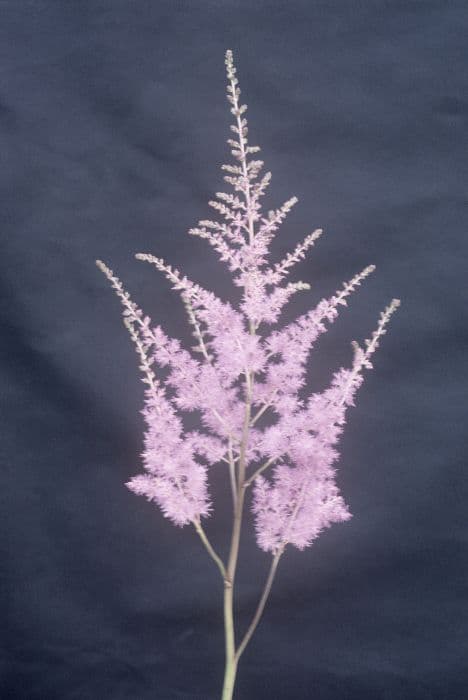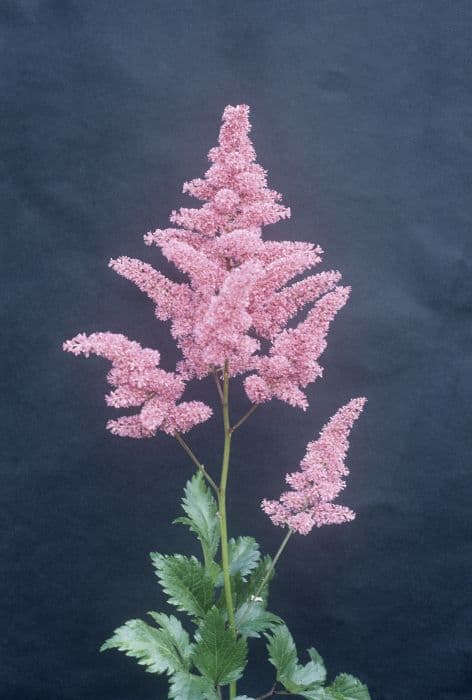Purple Bergenia Bergenia purpurascens 'Irish Crimson'

ABOUT
Bergenia purpurascens 'Irish Crimson', commonly known as elephant's ears due to its large, rounded leaves that resemble an elephant's ears, is admired for its impressive foliage and flowers. The leaves are thick, leathery, and glossy, showcasing a rich green color that transitions to a striking crimson or purple shade in colder weather, which is where it gets its name ‘Irish Crimson’. The plant boasts robust, upright stems which hold aloft clusters of bell-shaped flowers. These blooms tend to come in a variety of pinks, starting out a lighter pink and deepening to a darker hue as they mature, creating a charming gradient effect. The overall appearance is a lush, mounded clump that provides a pop of vibrant color to the garden, particularly noticeable during the blooming season. The dramatic shift in leaf color from green to crimson as the seasons change adds year-round interest to any plant display.
About this plant
 Names
NamesFamily
Saxifragaceae
Synonyms
Elephant's Ears, Pigsqueak, Heart-leaved Bergenia, Leather Bergenia, Irish Crimson Bergenia
Common names
Bergenia purpurascens.
 Toxicity
ToxicityTo humans
Bergenia, commonly known as Elephant's Ears, is generally considered to have a low level of toxicity to humans. If ingested, it may cause mild gastrointestinal upset, such as nausea, vomiting, or diarrhea. These symptoms would likely result from the saponins present in the plant, which can be irritating. However, severe poisoning is rare, and it is typically not considered a dangerous plant to humans. As with any non-edible plant, it's prudent to avoid ingesting it and supervise children who may be curious.
To pets
Elephant's Ears may also have a low level of toxicity to pets if ingested. Pets, like cats and dogs, may experience mild gastrointestinal upset, which can include symptoms such as vomiting, diarrhea, or drooling. This discomfort is caused by saponins, which have the potential to irritate the stomach and intestines. Although not typically life-threatening, it's advisable to keep an eye on pets to prevent them from chewing on these plants. If a pet appears to be in distress or symptoms persist, contacting a veterinarian is recommended.
 Characteristics
CharacteristicsLife cycle
Perennials
Foliage type
Evergreen
Color of leaves
Green
Flower color
Crimson
Height
1 foot [0.3 meters]
Spread
2 feet [0.6 meters]
Plant type
Herb
Hardiness zones
5
Native area
Himalayas
Benefits
 General Benefits
General Benefits- Attractive Foliage: Bergenia purpurascens 'Irish Crimson' has large, leathery leaves that turn reddish-purple in the fall, bringing color to the garden year-round.
- Low Maintenance: This plant is easy to care for, requiring minimal attention once established, which makes it a great choice for gardeners of all levels.
- Drought Tolerant: Once established, it can tolerate periods of dryness, making it suitable for xeriscaping or gardens in drier climates.
- Cold Hardy: It is capable of surviving in cooler temperatures, which makes it a robust choice for many climates.
- Versatile: Can be used in a variety of garden settings such as borders, ground covers, and rock gardens.
- Evergreen: The plant remains evergreen in milder climates, providing year-round interest and ground cover.
- Attracts Wildlife: Bees and butterflies are drawn to its flowers, promoting biodiversity in the garden.
- Seasonal Blooms: The plant produces clusters of magenta flowers in the spring, adding seasonal beauty to outdoor spaces.
- Erosion Control: Its dense growth habit helps prevent soil erosion on slopes and banks.
- Non-Invasive: Unlike some other garden plants, Bergenia purpurascens 'Irish Crimson' is not known to be invasive, so it won’t overtake other plants in the garden.
 Medical Properties
Medical PropertiesThis plant is not used for medical purposes.
 Air-purifying Qualities
Air-purifying QualitiesThis plant is not specifically known for air purifying qualities.
 Other Uses
Other Uses- Bergenia leaves can be used for dyeing fabric, giving it a natural reddish-purple tint derived from the plant's own pigmentation.
- The large leaves of Bergenia can be creatively included in floral arrangements for an exotic touch.
- When dried, the leaves can serve as a natural insect repellent, due to the presence of certain compounds that insects find unattractive.
- The robust leaves can be used as natural bookmarks, with their stiff texture and durability.
- Fresh Bergenia leaves could be used as eco-friendly disposable plates or wrappers for foods in outdoor settings.
- Bergenia can be incorporated into art projects, such as leaf printing, due to its detailed veining and broad leaf surface.
- The plant's striking foliage can be used to provide a lush green backdrop in aquariums, though typically not submerged.
- Pressed Bergenia leaves can be used in the craft of decoupage, providing a unique texture and color to various decoupage projects.
- The robust nature of Bergenia leaves makes them suitable for use as natural tracing paper for artists and designers.
- Bergenia can be planted in areas prone to soil erosion to help stabilize and reduce the impact of erosive forces.
Interesting Facts
 Feng Shui
Feng ShuiThe plant Bergenia is not used in Feng Shui practice.
 Zodiac Sign Compitability
Zodiac Sign CompitabilityThe plant Bergenia is not used in astrology practice.
 Plant Symbolism
Plant Symbolism- Visibility and Presence: With its striking 'Irish Crimson' flowers, the Bergenia symbolizes standing out and being visible. It reminds one to be noticed and take up space boldly.
- Endurance and Resilience: Often thriving in tough conditions, the Bergenia signifies resilience. It encourages one to stay strong through adversity.
- Adaptation: As a plant that adapts to different environments, the Bergenia represents flexibility and the ability to thrive in various circumstances.
- Lasting Affection: With its long-lasting blooms, the Bergenia can symbolize enduring love or affection, suggesting a relationship that withstands the test of time.
 Water
WaterElephant's Ears should be watered deeply until the water starts to drain from the bottom of the pot or saturates the surrounding soil, ensuring the moisture reaches the roots. Aim to water every week during the growing season, but reduce the frequency to every two to three weeks during fall and winter. The amount of water needed will depend on the size of the plant and the pot, but as a guideline, use about half a gallon for a medium-sized plant every time you water. Always check the top inch of the soil for dryness before watering again to avoid overwatering.
 Light
LightElephant's Ears thrive best in partial shade to full sunlight. A spot that receives morning sunlight and afternoon shade would be ideal, as too much direct sunlight can scorch the leaves. They can adapt to lower light conditions but won't flower as prolifically. Ensure the plant receives at least four to six hours of filtered light for optimal growth.
 Temperature
TemperatureElephant's Ears do well in average room temperatures ranging from 60 to 75 degrees Fahrenheit. They can survive a temporary dip down to about 30 degrees Fahrenheit, but frost can severely damage the plant. For the best growth and flowering, keep them in an area where the temperature does not fluctuate drastically and stays within their comfort zone.
 Pruning
PruningPruning Elephant's Ears involves removing any dead or damaged leaves to maintain plant health and appearance. This should be done as needed throughout the year, using clean, sharp shears. The best time to conduct more extensive pruning is in the spring before new growth begins, which encourages a bushier plant and better blooms.
 Cleaning
CleaningAs needed
 Soil
SoilElephant's ears prefer a soil mix that is rich in organic matter with good drainage. A mixture of loam, peat, and sharp sand is ideal, providing a balance of moisture retention and drainage. The soil pH should be slightly acidic to neutral, in the range of 5.5 to 7.5, to allow optimal nutrient uptake for the plant.
 Repotting
RepottingElephant's ears should generally be repotted every 2 to 3 years to refresh the soil and accommodate growth. As they are relatively slow growers, there's no need for frequent repotting unless the plant has outgrown its container.
 Humidity & Misting
Humidity & MistingElephant's ears thrive in moderate to high humidity conditions but can tolerate average indoor humidity levels. Aim for a humidity level between 50% and 60% for optimal growth and to promote healthy foliage.
 Suitable locations
Suitable locationsIndoor
Place in bright, indirect light with average humidity.
Outdoor
Partial shade, sheltered location, enrich soil with compost.
Hardiness zone
4-9 USDA
 Life cycle
Life cycleIrish Crimson Bergenia begins its life cycle as a seed, which upon germination in favorable conditions, develops into a small seedling. The seedling stage is followed by the growth of foliage, with leathery, dark green leaves that can take on a crimson hue in the colder months. As it matures, the plant forms a basal rosette from which flower stalks emerge in early to mid-spring, displaying pink to ruby-red blooms. After the flowering stage, the plant sets seed, which can be dispersed by various means to create new plants. Post blooming, Irish Crimson Bergenia continues to grow vegetatively, and may also propagate asexually through its thick rhizomes, producing clonal offshoots. This perennial plant goes through a dormancy period in the winter, after which it recommences its growth cycle in the spring.
 Propogation
PropogationPropogation time
Spring-Early Summer
Propogation: The Bergenia purpurascens 'Irish Crimson', commonly known as Bergenia, is best propagated during the spring or early summer months to allow sufficient time for the plant to establish itself before the onset of winter. The most popular method of propagation for this plant is by division, which involves separating the plant's rhizomes. To propagate by division, carefully dig around the Bergenia to lift the plant from the ground, ensuring minimal disturbance to the root system. Once lifted, use a sharp, clean knife or spade to divide the rhizomes into sections, each with at least one growth point or 'eye'. Plant these sections into moist, well-draining soil, maintaining the same planting depth as the original plant, and water them in well. This simple approach allows for reliable and relatively fast multiplication of the Bergenia and ensures that the new plants will be true to the parent plant in terms of their characteristics.









